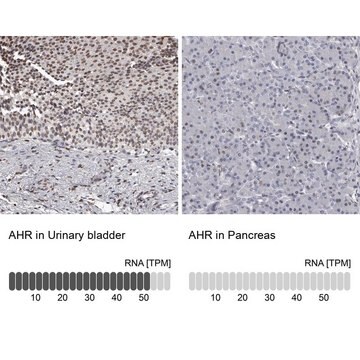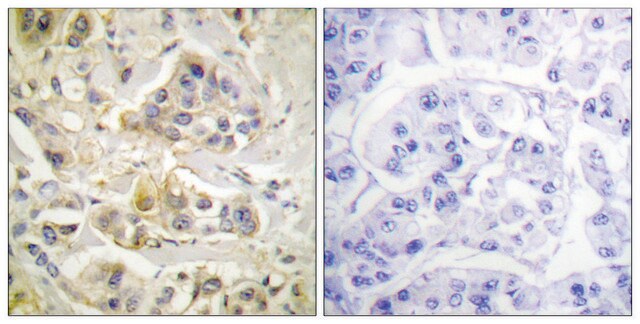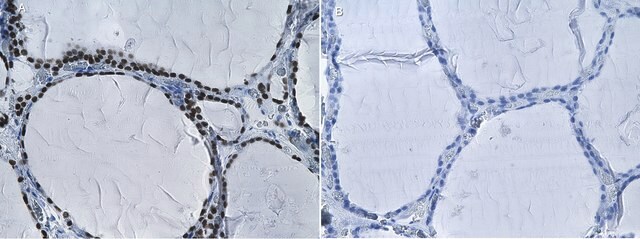詳細
We are committed to bringing you greener alternative products, which adhere to one or more of The 12 Principles of Green Chemistry.This antibody is Preservative-free, produced without the harm or sacrifice of animals and exceptionally stable to allow for ambient shipping and storage if needed and thus aligns with "Waste Prevention", "Designing Safer Chemicals" and "Design for Energy Efficiency".
Click here for more information.
ZooMAb® antibodies represent an entirely new generation of recombinant monoclonal antibodies.Each ZooMAb® antibody is manufactured using our proprietary recombinant expression system, purified to homogeneity, and precisely dispensed to produce robust and highly reproducible lot-to-lot consistency. Only top-performing clones are released for use by researchers. Each antibody is validated for high specificity and affinity across multiple applications, including its most commonly used application. ZooMAb® antibodies are reliably available and ready to ship when you need them.
特異性
Clone 1H8 is a ZooMAb® Rabbit recombinant monoclonal antibody that specifically detects Aryl hydrocarbon receptor (AHR). It targets an epitope within 22 amino acids from the C-terminal region.
免疫原
KLH-conjugated linear peptide corresponding to 22 amino acids from the C-terminal region of human Aryl hydrocarbon receptor (AHR).
アプリケーション
Quality Control Testing
Evaluated by Western Blotting in U87 MG cell lysate.
Western Blotting Analysis: A 1:1,000 dilution of this antibody detected Aryl Hydrocarbon Receptor (AHR) in U87MG cell lysate.
Tested Applications
Western Blotting Analysis: A 1:1,000 dilution from a representative lot detected Aryl Hydrocarbon Receptor (AHR) in HeLa cell nuclear extract and in Mouse lung tissue lysate.
Immunocytochemistry Analysis: A 1:100 dilution from a representative lot detected Aryl Hydrocarbon Receptor (AHR) in U87MG cells.
Immunohistochemistry (Paraffin) Analysis: A 1:100 dilution from a representative lot detected Aryl Hydrocarbon Receptor (AHR) in human placenta tissue sections.
Affinity Binding Assay: A representative lot of this antibody bound Aryl hydrocarbon Receptor (AHR) peptide with a KD of 5.3 x 10-7 in an affinity binding assay.
Note: Actual optimal working dilutions must be determined by end user as specimens, and experimental conditions may vary with the end user.
ターゲットの説明
Aryl hydrocarbon receptor (UniProt: P35869; also known as Ah receptor, AhR, Class E basic helix-loop-helix protein 76, bHLHe76) is encoded by the AHR (also known as BHLHE76) gene (Gene ID: 196) in human. AHR is a member of the periodic circadian protein (PER)-AHR nuclear translocator (ARNT)-single-minded protein (SIM) superfamily that serves as a ligand-activated transcription factor. It is reported to integrate environmental, dietary, microbial, and metabolic cues to control complex transcriptional programs in a ligand-and cell-specific manner. It is widely expressed and is detected in all tissues tested including blood, brain, heart, kidney, liver, lung, pancreas, and skeletal muscle. Its expression is also observed in retinal photoreceptors. AHR remains in an inactive state in a complex of HSP90, AHR-interacting protein (AIP), co-chaperone p23, and protein kinase SRC. Upon binding of an agonist, AIP dissociates from the complex that results in exposure of the AHR amino-terminal nuclear localization signal and an adjacent nuclear export signal. This allows AHR-ligand complex to translocate to the nucleus in a transportin-dependent and importin-β-dependent manner. In the nucleus, it heterodimerizes with ARNT and induces transcription by binding to xenobiotic response elements (XRE). Several xenobiotics are known to act as its ligands and xenobiotic-binding is known to activate the expression of multiple phase I and II xenobiotic chemical metabolizing enzyme genes. The AHR-ARNT heterodimer binds to core DNA sequence 5′-TGCGTG-3′ within the dioxin response element (DRE) of target gene promoters and activates their transcription. Mutations in AHR gene have been linked to retinitis pigmentosa 85 that is characterized by retinal pigment deposits and loss of rod photoreceptor cells followed by secondary loss of cone photoreceptors. This ZooMAb® recombinant monoclonal antibody, generated by our propriety technology, offers significantly enhanced specificity, affinity, reproducibility, and stability over conventional monoclonals. (Ref.: Rothhammer, V., and Quintana, FJ. (2019). Nat. Rev. Immunol. 19; 184-197; Schulte, KW., et al. (2017). Structure. 25(7); 1025-1033; Ikuta, T., et al (2000). J. Biochem. 127(3); 503-509).
物理的形状
Purified recombinant rabbit monoclonal antibody IgG, lyophilized in PBS with 5% Trehalose, normal appearance a coarse or translucent resin. The PBS/trehalose components in the ZooMAb formulation can have the appearance of a semi-solid (bead like gel) after lyophilization. This is a normal phenomenon. Please follow the recommended reconstitution procedure in the data sheet to dissolve the semi-solid, bead-like, gel-appearing material. The resulting antibody solution is completely stable and functional as proven by full functional testing. Contains no biocide or preservatives, such as azide, or any animal by-products. Larger pack sizes provided as multiples of 25 µL.
再構成
0.3 mg/mL after reconstitution at 25 µL per vial. Please refer to guidance on suggested starting dilutions and/or titers per application and sample type.
保管および安定性
Recommend storage of lyophilized product at 2-8°C; Before reconstitution, micro-centrifuge vials briefly to spin down material to bottom of the vial; Reconstitute each vial by adding 25 µL of filtered lab grade water or PBS; Reconstituted antibodies can be stored at 2-8°C, or -20°C for long term storage. Avoid repeated freeze-thaws.
法的情報
ZooMAb is a registered trademark of Merck KGaA, Darmstadt, Germany
免責事項
Unless otherwise stated in our catalog or other company documentation accompanying the product(s), our products are intended for research use only and are not to be used for any other purpose, which includes but is not limited to, unauthorized commercial uses, in vitro diagnostic uses, ex vivo or in vivo therapeutic uses or any type of consumption or application to humans or animals.










